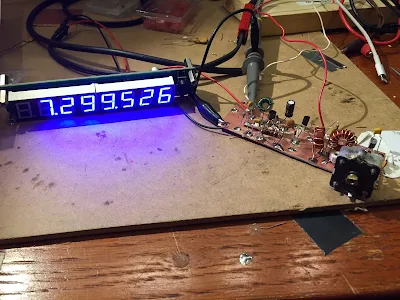Gentlemen,
I'm a younger ham, just 26, and I've just experienced what I think you call Joy Of Oscillation as I completed my first L-C VFO. What fun!
I'm working on Peter Parker VK3YE's Beach 40 Double-Sideband transceiver, and while my natural proclivity is toward the SI5351 and it's brethren, I figured it would be character-building to actually put together an analog VFO for once.
After much tweaking of the feedback capacitor in the oscillator, and massaging the tank inductors, and conking out an additional buffer stage to drive the diode-ring mixer at the appropriate level, and gluing Manhattan pads on top of Island pads.... I say, without reservation, that this was great radio fun! And isn't that what it's all about?
I'm working on Peter Parker VK3YE's Beach 40 Double-Sideband transceiver, and while my natural proclivity is toward the SI5351 and it's brethren, I figured it would be character-building to actually put together an analog VFO for once.
After much tweaking of the feedback capacitor in the oscillator, and massaging the tank inductors, and conking out an additional buffer stage to drive the diode-ring mixer at the appropriate level, and gluing Manhattan pads on top of Island pads.... I say, without reservation, that this was great radio fun! And isn't that what it's all about?
(Now it only it didn't drift so much... so I guess it's not quite complete yet)
Just wanted to share, love the podcast and the blog, I learn something new each episode.
All the Best,
All the Best,
Jeff, KK9JEF
---------------------------
Great stuff Jeff. Character building indeed! As for the drift, try this:
-- Replace the toroid in the oscillator circuit with a coil wound on a non-metallic core. I use a cardboard tube from a coat hanger.
-- Make sure the capacitors in the oscillator and even in the buffer are NP0 caps (they don't change in value as they heat).
-- Try to run the oscillator stage at reduced voltage. Six volts is better than nine.
-- After you solder, always let the device cool down for several hours (or even overnight) before you evaluate it. Heat from the soldering iron will be dissipating and changing the freq for a LONG time.
Above all, IGNORE the inevitable recommendation from Pete Juliano that you forget about all this nonsense and just go with an Si5351.
Please keep us posted on your progress.
73 Bill N2CQR

Well done, Jeff!
ReplyDeleteIn addition to Bill's comments, I've found it helpful to distribute the "tank" capacitance over a few capacitors rather than one.
If you try all of these suggestions and it still drifts, chuck it all and use an Si5351!
73 and running for cover!
-Steve N8NM